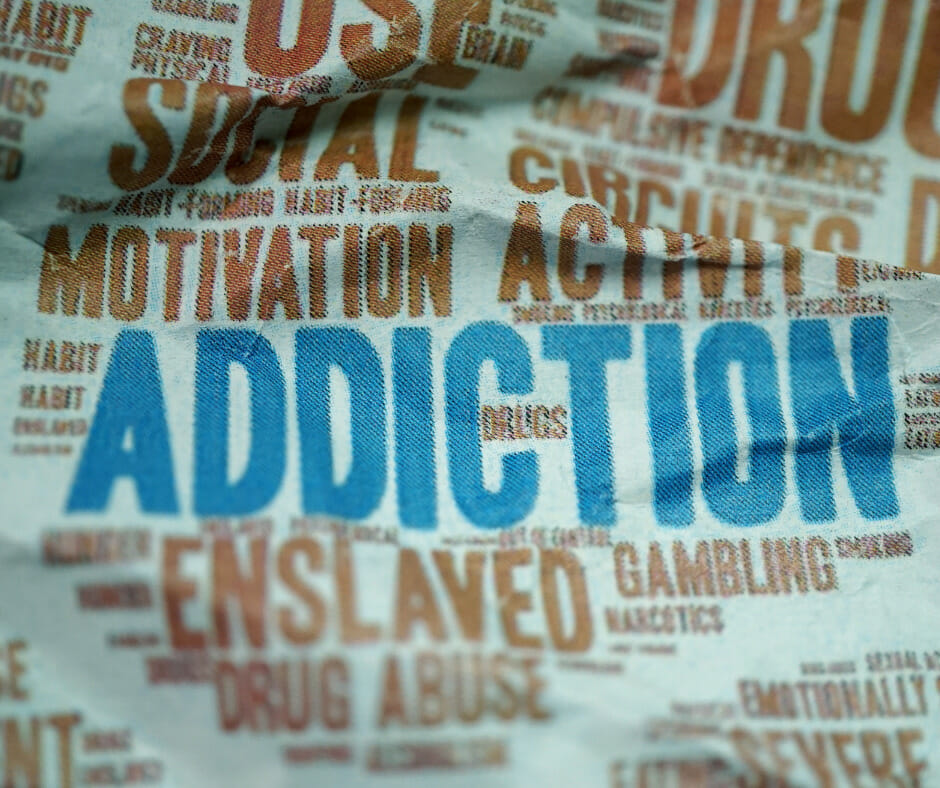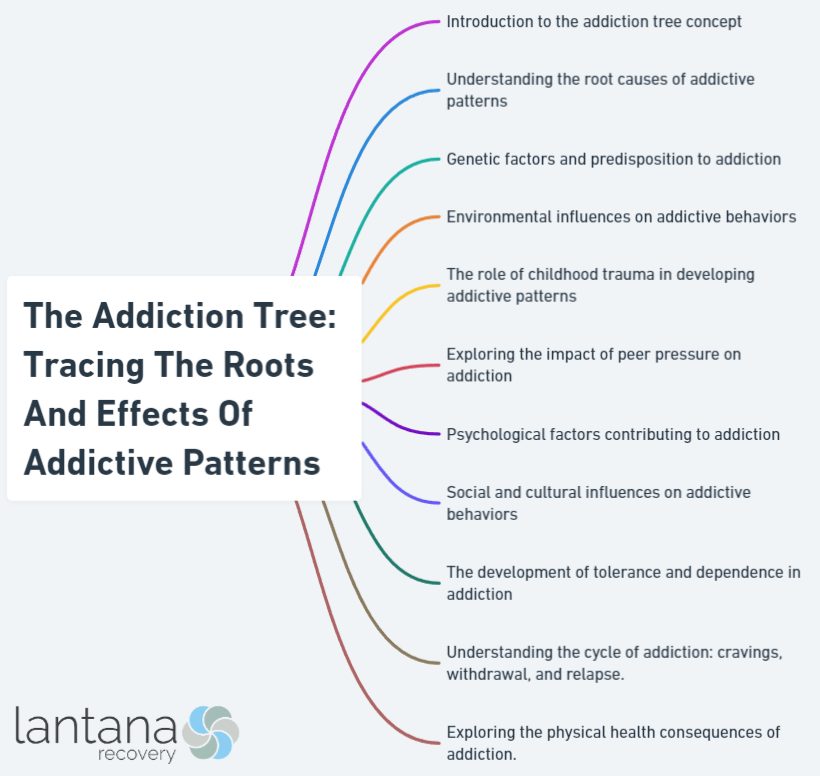Addiction is a complex and multi-faceted issue that affects millions of individuals worldwide. Understanding the roots and effects of addictive patterns is crucial in addressing this widespread problem. This article delves into the metaphorical concept of the “addiction tree,” tracing the different components that contribute to addiction and exploring its far-reaching effects.
The roots of addiction can be traced to various elements, including genetic predisposition, environmental factors, psychological factors, and social influences. The role of genetic vulnerability in predisposing individuals to addiction and environmental factors such as early exposure to substances or a traumatic event can also contribute to addiction. Psychological factors such as mental health disorders, low self-esteem, and poor coping skills, along with social factors like peer pressure or cultural influences, can further shape addictive behaviors.
Triggers and patterns play a significant role in addiction. Emotional triggers, such as stress, anxiety, or trauma, can compel individuals to seek solace in addiction. Social triggers, such as social situations or peer pressure, can also contribute to the perpetuation of addictive patterns. Environmental triggers, such as specific locations or situations associated with substance use, can reinforce addictive behaviors. Behavioral patterns, like compulsive or impulsive tendencies, can further solidify addiction.
The effects of addiction are far-reaching and can infiltrate every aspect of an individual’s life. Physically, addiction can result in deterioration of health, organ damage, and increased vulnerability to diseases. Mentally and emotionally, addiction can lead to cognitive impairment, mood disorders, anxiety, and depression. Addiction can strain relationships, isolate individuals, and negatively impact social connections. Furthermore, addiction can wreak havoc on financial stability, career prospects, and overall professional well-being.
By understanding the roots, triggers, and effects of addiction, individuals can work towards breaking free from addictive patterns and reclaiming their lives. This article aims to provide valuable insights and guidance on this challenging journey towards recovery.

Defining Addiction
It is important to understand the features of addiction in order to recognize and address it effectively. To comprehend the addiction tree, we must first recognize the factors that contribute to the development of addictive patterns:
1. Loss of control: Addiction is marked by an inability to control impulses and cravings. Individuals with addiction may excessively engage in the behavior or consume the substance, even after previous efforts to stop.
2. Dependence: Addiction often involves physical or psychological dependence on the behavior or substance. This means individuals may experience withdrawal symptoms or psychological distress when trying to reduce or stop their engagement.
3. Negative consequences: Addiction is associated with negative consequences in health, relationships, and finances. It can lead to physical health issues, mental and emotional distress, strained relationships, and difficulties in professional and financial domains.
4. Compulsive behavior: Addiction is characterized by an uncontrollable urge to engage in the behavior or consume the substance, often at the expense of other responsibilities. This compulsivity overrides rational decision-making and leads to a cycle of repetitive behaviors. For instance, Mark Griffiths’ 2008 study on internet and video-game addiction explored how excessive video game playing seems to have potentially harmful effects on a minority of individuals who exhibit compulsive and addictive behavior, going to any lengths to “fuel their addiction.”
5. Persistent pursuit: Despite negative consequences, individuals with addiction continue to engage in the behavior or consume the substance due to a strong desire for pleasurable effects or to alleviate withdrawal symptoms.
Understanding the aspects of addiction helps individuals recognize the signs and seek appropriate help and support. If you or someone you know is struggling with addiction, reach out to professionals who can provide guidance and assistance in breaking the cycle of addiction.
Pro-tip: Approach addiction with empathy and understanding. Remember that it is a complex condition that requires professional help and a supportive network.

The Addiction Tree: A Metaphor for Addictive Patterns
The addiction tree metaphor serves as a helpful tool for comprehending addictive patterns. Just like a tree, addictive patterns consist of various components. Let’s examine these key elements:
1. Roots: These represent the underlying causes and risk factors associated with addiction, such as genetics, trauma, environment, and mental health conditions.
2. Trunk: The trunk symbolizes the core aspects of addiction, encompassing compulsive behavior and the loss of control.
3. Branches: These branches represent the different manifestations and behaviors linked to addiction, including substance abuse, gambling, and shopping.
4. Leaves: The leaves signify the consequences and effects of addiction, encompassing physical health problems, strained relationships, financial difficulties, and “research evidences indicate that many psychological factors are involved in drug addiction and subsequent relapse (Relapse Coping Strategies in Young Adults Addicts: A Quantitative Study in Iran, Shafiei et al., 2016)
By addressing and understanding these integral components, individuals can develop a deeper insight into their addictive patterns and subsequently embark on a path of recovery and healing.
For instance, Sarah’s struggle with alcohol addiction was influenced by her family history (roots). Her compulsion to drink led her down a destructive path, resulting in strained relationships (branches), as well as job loss and legal trouble (leaves). However, by seeking help and addressing the underlying issues, Sarah was able to break free from addiction and cultivate a healthier and happier life.
The Roots of Addiction
Delving into the depths of addiction, we begin unraveling the intricate web of influences that lay at the core. Let’s focus on the roots of addiction, exploring the various factors that contribute to the development of addictive patterns. From genetic predisposition to environmental, psychological, and social influences, we’ll uncover the pieces of the puzzle that shape addiction’s stronghold. Prepare to journey through the complexities and gain insight into the fundamental forces that underlie addictive behaviors.
Genetic Predisposition
Genetic predisposition plays a significant role in the development of addiction. Research shows that individuals with family members who struggle with addiction are more likely to have a genetic predisposition to addictive behaviors. Certain genetic factors can influence how our brains respond to substances, making some people more susceptible to addiction. For example, variations in genes related to dopamine receptors or serotonin can impact the brain’s reward system and increase the risk of addiction.
A true story that demonstrates the impact of genetic predisposition is that of Sarah, whose father had an alcohol addiction. Despite her genetic risk, Sarah consciously avoided alcohol and utilized healthy coping mechanisms. She focused on building a strong support system and finding alternative ways to manage stress. Sarah’s awareness empowered her to make informed choices and break the cycle of addiction in her family.
Environmental Factors
Addiction is influenced by various environmental factors that can contribute to its development and progression. These factors can increase a person’s vulnerability and play a significant role in recovery.
| Environmental Factors | Impact on Addiction |
|---|---|
| Family Environment | The family environment, including family dynamics and substance abuse within the family, significantly influences the likelihood of addiction. Growing up in a home with addiction increases the risk of developing addictive behaviors. |
| Peer Pressure | Peer pressure is a powerful environmental factor contributing to addiction. The desire to fit in and be accepted by peers can lead individuals to engage in substance abuse and adopt addictive behaviors. |
| Availability of Substances | The easy accessibility of addictive substances contributes to the development of addiction. Living in an environment where alcohol, drugs, or other addictive substances are readily available increases the risk of substance abuse and addiction. |
| Stressful Life Events | Experiencing traumatic or stressful life events, such as loss, abuse, or significant life changes, increases vulnerability to addiction. These events can contribute to the development of coping mechanisms involving substance abuse. |
| Socioeconomic Factors | Socioeconomic factors, such as poverty, unemployment, and limited access to education and healthcare, contribute to the development of addiction. These factors increase stress levels and limit resources for seeking help or treatment. |
Understanding and addressing these environmental factors is crucial for preventing and treating addiction. By creating a supportive and healthy environment, individuals can reduce their risk of addiction and enhance their chances of successful recovery.
Throughout history, environmental factors have been recognized as influential in the development and maintenance of addiction. Researchers have studied the impact of environmental factors on addiction for decades, highlighting the significance of family, peers, and substance availability. This knowledge has guided interventions and prevention strategies targeting these environmental influences. By addressing environmental factors, we can create a society that promotes well-being and resilience, reducing the prevalence and impact of addiction. Understanding the role of environmental factors in addiction is essential not only for individuals struggling with addiction but also for policymakers, healthcare professionals, and communities working towards a healthier and addiction-free future.
Psychological Factors
Psychological factors are crucial in addiction and can significantly contribute to addictive patterns. These factors encompass thoughts, emotions, beliefs, and coping mechanisms. Having a comprehensive understanding of these psychological factors is essential for effectively addressing addiction.
One of the key psychological factors is emotional regulation. Individuals who struggle with managing and regulating their emotions often find themselves prone to addiction. They may resort to using substances or engaging in addictive behaviors as a way to cope with negative emotions and seek pleasure.
Additionally, ineffective or maladaptive coping mechanisms can make individuals more vulnerable to addiction. People who rely on substances or addictive behaviors to alleviate stress, anxiety, or other emotional challenges are at a higher risk of developing addiction.
Low self-esteem and feelings of inadequacy are also significant psychological factors that can contribute to addiction. Individuals with low self-esteem may turn to substances or addictive behaviors to boost their self-confidence or escape feelings of worthlessness.
Furthermore, psychological factors can be intertwined with co-occurring mental health disorders such as depression, anxiety, or trauma. These underlying mental health issues can heighten the risk of addiction and complicate the recovery process.
To exemplify the impact of psychological factors in addiction and the importance of addressing them for successful recovery, let’s consider Sarah’s true story. Sarah battled with low self-esteem and anxiety throughout her teenage years. Overwhelmed and lacking confidence, she sought solace in alcohol to escape her troubles. Sarah believed that alcohol helped her feel accepted and confident in social situations. However, her reliance on alcohol progressively worsened, negatively impacting her relationships and overall well-being. Fortunately, through therapy and support groups, Sarah confronted her psychological factors and developed healthier coping mechanisms, ultimately liberating herself from addiction.
Sarah’s story serves as a powerful testament to the influence of psychological factors on addiction. It underscores the vital role of addressing these factors in achieving a successful recovery.
Social Factors
Social factors are crucial in the development and perpetuation of addiction. These social factors can greatly impact a person’s susceptibility to addiction and their ability to recover. It is important to consider the following key social factors:
- Peer pressure: Peers have a strong influence on an individual’s decision to engage in substance abuse. Peer pressure often arises from the desire to fit in or be accepted within a social group.
- Family dynamics: The environment and relationships within a family can contribute to addiction. Neglect, abuse, or dysfunctional family dynamics increase the risk of addiction.
- Socioeconomic status: Economic inequalities and the lack of resources can contribute to substance abuse. Financial hardships or living in disadvantaged communities can lead individuals to use substances as a way to cope.
- Cultural norms and attitudes: Cultural beliefs and societal attitudes towards addiction can shape a person’s perception of substance abuse. The stigma or normalization of drug and alcohol use can affect the willingness to seek help.
- Social support: The presence or absence of a strong social support system can influence an individual’s ability to overcome addiction. Supportive relationships, such as friends, family, or recovery communities, play a critical role in the recovery process.
Understanding the role of social factors in addiction is vital for implementing effective prevention and treatment strategies. By addressing these factors, we can establish a supportive and inclusive society that promotes resilience and well-being.
Throughout history, social factors have been acknowledged as influential in breaking the cycle of addiction. Social dynamics have played a significant role in shaping patterns of substance abuse in various societies and time periods. For instance, during the Prohibition era in the United States, rebellion against restrictive laws contributed to the emergence of illegal alcohol consumption and organized crime. In recent times, the rise of social media has introduced new social pressures, further contributing to addictive behaviors such as excessive smartphone use and online gaming. Studying and understanding the social factors involved in addiction enable the development of targeted interventions and policies to address this complex issue.

The Triggers and Patterns of Addiction
Unveiling the triggers and patterns that feed addictive behaviors is like delving into the dark roots of an addiction tree. In this section, we will take a closer look at a range of triggers that nourish addictive patterns. From the emotional undercurrents that push individuals towards a substance or behavior, to the social influences that normalize and perpetuate addictive habits, and the environmental factors that shape our choices – we’ll dive into these triggers and explore the swirling whirlwind of behavioral patterns that result from addiction.
Emotional Triggers
Emotional triggers play a crucial role in the development and perpetuation of addiction. They have the ability to spark intense emotions that drive individuals to seek out destructive coping mechanisms. Understanding and recognizing these triggers is essential in order to break free from the cycle of addiction.
One common emotional trigger is stress. When faced with overwhelming stress, individuals may turn to addictive substances or behaviors as a means of escape or to numb their emotions.
Past trauma can also resurface and act as a trigger for addictive patterns. Feelings of powerlessness resulting from trauma can lead individuals to seek temporary relief through addictive substances or behaviors.
Feelings of loneliness and isolation can be significant triggers for addiction as well. In an attempt to seek connection or solace, individuals may turn to substances or engage in addictive behaviors.
Unresolved emotional pain, such as grief, loss, or heartbreak, can also act as triggers for addiction. Individuals may use substances or behaviors as a way to numb their pain or distract themselves from their emotions.
It is important to note that emotional triggers can vary from person to person. What triggers one individual may not have the same effect on another. It is crucial for individuals to identify and understand their personal triggers in order to achieve successful recovery.
Sarah, a 35-year-old woman, would often turn to alcohol when experiencing feelings of anxiety or stress. Whenever she had a demanding day at work or faced conflict in her personal life, her immediate response would be to reach for a bottle of wine. However, through therapy and support groups, Sarah was able to recognize her triggers and develop healthier coping strategies. She learned mindfulness exercises and journaling as effective ways to manage her emotions. By addressing the underlying emotional issues, Sarah was able to break free from her addiction and regain control of her life.
Social Triggers
Play a significant role in addiction. These triggers encompass various social factors and situations that contribute to addictive behavior. Recognizing and understanding these social triggers is essential to effectively address and overcome addiction.
1. Peer pressure and social groups have a strong influence on addiction. People may engage in addictive behaviors to fit in, gain acceptance, or seek approval from their peers.
2. The desire for social acceptance and the fear of rejection can trigger addiction patterns. Individuals may turn to substances or behaviors prevalent in their social circles to feel included and avoid isolation.
3. Lack of emotional support or unhealthy relationships can also trigger addiction. People often turn to substances or behaviors to cope with emotional pain, loneliness, or stress.
4. Cultural norms and expectations around substance use or certain behaviors can contribute to addiction triggers. Beliefs, traditions, and social norms influence attitudes and decisions regarding addictive behaviors.
5. The portrayal and promotion of addictive substances or behaviors in the media act as social triggers. Advertisements, movies, or social media influencers may glamorize or normalize addictive behaviors, making them more appealing and acceptable.
Understanding these social triggers is crucial in breaking the cycle of addiction. By addressing these triggers, individuals can develop healthier coping mechanisms, build stronger support systems, and create environments that support recovery. Overcoming social triggers requires a multifaceted approach involving individual awareness, lifestyle changes, and the support of professionals and loved ones.
Environmental Triggers
Environmental triggers are known to play a significant role in addictive patterns. These triggers encompass external factors that can greatly increase the likelihood of addictive behavior. It is crucial to have an awareness of these triggers in order to better comprehend and address addiction effectively. Here are several common examples of environmental triggers:
-
Availability: Easy access to addictive substances, such as alcohol or drugs, significantly raises the risk of addiction. When these substances are readily available, it becomes increasingly difficult to resist the temptation.
-
Peer Influence: Surrounding oneself with friends or social circles where substance abuse is prevalent can strongly influence one’s behavior. The pressures of peer influence and the desire to fit in can eventually lead to addictive behaviors.
-
Stressful Environments: Being in high-stress situations at work, home, or in relationships can often lead individuals to use substances as a coping mechanism. The need for stress relief and a desire to escape from difficulties contribute to the development of addiction.
-
Traumatic Events: Experiencing trauma or witnessing distressing events can act as triggers for addiction. Individuals facing such situations may turn to substances in order to numb emotional pain or cope with traumatic memories.
-
Enabling Environments: Environments that either normalize or endorse substance abuse significantly contribute to the development of addiction. The lack of support and accountability in such environments makes it even more challenging to break free from addiction.
Understanding and addressing these environmental triggers is essential for achieving successful addiction recovery. By identifying and avoiding these triggers, individuals can create healthier environments that support their sobriety and overall well-being.
An example of how environmental triggers can impact recovery is Jeffrey’s struggle with alcohol addiction. After realizing that his workplace served as a major trigger due to after-work socializing involving drinking, Jeffrey made the difficult decision to change jobs. This change allowed him to remove this environmental trigger from his life. Jeffrey was fortunate to find a new job that fostered a healthier work culture, where colleagues engaged in alcohol-free activities. This significant change greatly enhanced his chances of maintaining sobriety and enabled him to build a support system with individuals who understood his journey. By eliminating this environmental trigger, Jeffrey was provided with a fresh start that greatly contributed to his recovery from addiction.
Behavioral Patterns
Behavioral patterns significantly impact addiction and an individual’s ability to break free. These patterns become ingrained in daily routines and must be understood and addressed for recovery to occur.
1. Compulsive behavior: Engaging in repetitive and uncontrollable behaviors without regard for consequences.
Examples: Compulsive gambling, and compulsive shopping.
2. Risk-taking behavior: Seeking out activities with a high potential for negative consequences, such as substance abuse or dangerous behaviors.
Examples: Drug abuse, and reckless driving.
3. Avoidance behavior: Avoiding situations or responsibilities that may trigger negative emotions or discomfort.
Examples: Avoiding social interactions, and procrastination.
4. Impulsivity: Acting without considering consequences, often driven by strong emotions.
Examples: Emotional eating, and impulsive spending.
These behavioral patterns reinforce addictive behaviors and make breaking free challenging. Recognizing these patterns is the first step toward recovery. With help from professionals at Lantana Recovery in Charleston, a drug rehab center, you can develop coping strategies to address and change these behaviors. Building a strong support system provides accountability and encouragement.

The Effects of Addiction
The Effects of Addiction are far-reaching, impacting various aspects of an individual’s life. From the physical toll, it takes on their health, to the profound effects on their mental and emotional well-being, as well as their relationships, finances, and professional endeavors. In this section, we will delve into the different dimensions of addiction’s impact, shedding light on the undeniable repercussions it has on individuals and society as a whole. Hang on tight, as we navigate through the intricate web of addiction’s consequences.
Physical Health Impacts
Addiction has significant impacts on physical health, including damage to vital organs such as the liver, heart, lungs, and kidneys. Excessive alcohol consumption can result in liver disease and weakening of the heart muscle. Addictive substances also increase the risk of developing chronic diseases such as cancer, diabetes, and cardiovascular disease.
Smoking is particularly problematic, as it is a major risk factor for lung cancer and heart disease. Furthermore, substance abuse weakens the immune system, rendering individuals more susceptible to infections and illnesses. Moreover, intravenous drug use can lead to the spread of bloodborne diseases like HIV and hepatitis.
It is important to note that addiction is closely intertwined with mental health disorders, which can worsen symptoms of depression, anxiety, and other psychiatric conditions. This further exacerbates the deterioration of physical health. In severe cases, addiction can even cause malnutrition, weight loss, and overall poor physical well-being.
Allow me to share a true story about a woman named Jane, who was a heavy smoker for many years. Due to her addiction, she developed chronic bronchitis and faced constant lung infections. Eventually, Jane was diagnosed with lung cancer, which required her to undergo chemotherapy and surgery. These treatments greatly affected her physical well-being. Jane’s story serves as a powerful reminder of the devastating physical health impacts of addiction.
Mental and Emotional Health Impacts
Addiction significantly affects mental and emotional health, making it a prime contributor to the development of mental health disorders such as anxiety, depression, and bipolar disorder. If left untreated, these conditions can worsen over time.
Emotional instability is a direct result of addiction, causing individuals to experience frequent shifts in mood, irritability, and difficulty managing their emotions. Such instability strains relationships and hampers effective functioning in all aspects of life.
Those battling addiction often suffer from low self-esteem and self-worth, experiencing shame, guilt, and a lack of confidence. These feelings further compound their mental and emotional struggles.
Moreover, addiction is commonly accompanied by co-occurring disorders like PTSD or eating disorders. The interaction between these conditions worsens their symptoms, making the journey to recovery even more challenging.
Furthermore, addiction leads to social isolation and withdrawal from friends, family, and support networks. The resulting loneliness, depression, and anxiety further impact one’s mental and emotional well-being.
Substance abuse impairs cognitive function, including memory, attention, and problem-solving skills. This impairment hinders individuals’ ability to perform daily tasks, maintain relationships, and make sound decisions.
To address the mental and emotional health impacts of addiction, comprehensive treatment approaches that incorporate therapy, counseling, and support groups are necessary. By prioritizing these aspects, individuals can strive towards regaining overall well-being and achieving long-lasting recovery.
Relationship and Social Impacts
When it comes to addiction, the relationship and social impacts can be significant. It is important to understand and recognize these effects in order to effectively address and overcome addiction:
1. Strained relationships: Addiction can strain relationships with family, friends, and partners. Trust may be broken, communication may deteriorate, and conflicts may arise due to the addict’s behavior or choices. This can lead to isolation, guilt, and sadness for both the addict and their loved ones.
2. Stigma and judgment: Society often stigmatizes addiction, resulting in judgment and discrimination. Those struggling with addiction may face social exclusion, rejection, or limited opportunities in areas like employment or housing. This can further isolate them and impact their self-esteem and overall well-being.
3. Social withdrawal: Addiction can cause individuals to withdraw from their social circles, isolating themselves from friends, family, and community activities. They may prioritize substance use over relationships or social events, resulting in a loss of connection and support.
4. Influence on support networks: Addiction can strain and even sever support networks. Concern or frustration may cause friends and family members to distance themselves, leaving the addict with fewer people to turn to for support during recovery.
5. Impact on children: For parents with addiction, the social impacts extend to their children. Addiction can disrupt family dynamics, affect children’s emotional well-being, and put them at risk of neglect or abuse. Losing healthy parental relationships can have long-lasting effects on a child’s development and future relationships.
To mitigate the relationship and social impacts of addiction, it is crucial for individuals to seek professional help, engage in therapy or support groups, and rebuild healthy relationships through open communication, trust-building, and sustained recovery. Creating a strong support system and actively working on repairing relationships is essential for long-term recovery and overall well-being.
Remember, breaking the cycle of addiction is a challenging but achievable journey, and seeking support is a crucial step toward rebuilding and maintaining healthy relationships.
Financial and Professional Impacts
Financial and professional impacts are significant consequences of addiction with far-reaching effects on individuals and their lives. Addiction can cause a severe financial strain as individuals prioritize their addiction over financial responsibilities. They may spend a significant amount of money on substances or engage in risky behaviors to support their addiction. This can result in mounting debt, loss of assets, and even bankruptcy. Addiction can also impair work performance, leading to job loss and reduced income.
Furthermore, addiction can have detrimental effects on an individual’s professional life. It can lead to decreased productivity, absenteeism, and poor job performance. These issues can ultimately result in job loss and difficulties in finding new employment. The stigma associated with addiction may also limit career opportunities and advancement.
Apart from financial and professional impacts, addiction can also strain relationships with family, friends, and colleagues. Trust may be broken due to money-related problems, compromising supportive networks. This can lead to isolation, feelings of guilt and shame, and a further downward spiral in individuals’ lives.
Moreover, addiction can result in legal issues, such as arrests and convictions related to illegal substances or behaviors associated with addiction. Legal consequences can further worsen financial and professional impacts, as individuals face fines, legal fees, and potential incarceration.
To overcome these challenges, individuals must address the financial and professional impacts of addiction through a comprehensive recovery plan. Seeking professional help, developing coping strategies, and building a support system are crucial steps toward rebuilding financial stability and finding new career opportunities.
Therefore, it is important to recognize and address the financial and professional impacts of addiction in order to break the cycle and work on addiction control with various strategies for managing and overcoming addictive behaviors.

Breaking the Cycle of Addiction
As defined by Berke & Hyman in Addiction, Dopamine, and the Molecular Mechanisms of Memory, addiction is a chronic disorder and even after treatment and extended periods of drug abstinence, the risk of relapse is high. Breaking free from the vicious cycle of addiction is a transformative journey, one that demands resilience, courage, and support. In this section, we’ll explore the steps to breaking the cycle: from recognizing the problem to seeking professional help, developing effective coping strategies, and building a strong support system. Each sub-section offers invaluable insights on how to overcome addiction and pave the way toward a healthier, more fulfilling life. Let’s unravel the path to liberation together.
Recognizing the Problem
Recognizing the problem of addiction is crucial to begin the journey toward recovery. Here are key factors to consider when identifying addiction:
1. Behavioral changes: One sign of addiction is a noticeable shift in behavior. This can include increased secrecy, withdrawal from loved ones, and engaging in risky or illegal activities.
2. Physical symptoms: Depending on the substance or behavior, physical symptoms may be present. These can range from bloodshot eyes and frequent nosebleeds to tremors and unexplained weight loss or gain.
3. Psychological distress: Addiction often goes hand in hand with psychological issues such as anxiety, depression, or mood swings. The individual may experience intense cravings, irritability, or an inability to stop engaging in addictive behavior.
4. Neglecting responsibilities: When addiction takes hold, individuals may start neglecting their obligations at work, school, or home. They may lose interest in activities they once enjoyed and prioritize their addiction above all else.
5. Financial difficulties: Addiction can cause a financial strain as money is redirected towards feeding the habit. This can result in unpaid bills, borrowing or stealing money, and a disregard for financial responsibilities.
Recognizing the problem is the first step toward addressing and overcoming addiction. Approach the situation with empathy and understanding, as addiction is a complex issue that requires support and professional help. Seek assistance from a healthcare professional or addiction specialist to successfully overcome addiction and reclaim a healthy and fulfilling life.
Seeking Professional Help
Seeking professional help from Lantana is absolutely essential when it comes to breaking the cycle of addiction. There are numerous reasons why it is so beneficial to do so:
1. Expert guidance: Addiction counselors and therapists have the knowledge and expertise to accurately assess your situation and provide appropriate treatment recommendations.
2. Specialized treatment options: Professional help gives you access to a wide range of treatment options that can be tailored to meet your specific needs. These options may include individual therapy, group therapy, medication-assisted treatment, or a combination of different approaches.
3. Addressing underlying issues: Professionals can assist you in identifying and resolving the psychological, emotional, or trauma-related factors that contribute to your addiction. By dealing with these issues, you can develop healthier coping mechanisms and reduce the risk of relapse.
4. Building a support network: Seeking professional help allows you to connect with a network of support, including other individuals in recovery, support groups, and community resources. Having a strong support system greatly increases your chances of long-term success in overcoming addiction.
If you or someone you know is struggling with addiction, it is important not to hesitate in seeking professional help. Remember, seeking help is a brave and crucial step towards a healthier and happier life.
Developing Coping Strategies
Developing coping strategies is essential when it comes to breaking the addiction cycle. By actively engaging in these strategies, individuals can effectively manage cravings and triggers, ultimately maintaining sobriety and preventing relapse.
One highly effective strategy is seeking professional help from addiction professionals. These experts can provide guidance, evidence-based treatment options, therapy, counseling, or support groups like Alcoholics Anonymous or Narcotics Anonymous.
Building a strong support system is also crucial in the recovery process. This involves developing a network of supportive individuals, such as family members, friends, or sponsors. These people provide encouragement, understanding, and accountability. Support groups and recovery communities can also offer a sense of belonging and connection.
Another important aspect of coping with addiction is regulating emotions. Recognizing and managing emotions is key, and various techniques can be used, such as mindfulness, deep breathing exercises, journaling, or therapy. These techniques address underlying emotional issues that contribute to addiction.
Engaging in self-care is also vital for reducing the risk of relapse and promoting overall well-being. This includes maintaining good nutrition, regularly exercising, getting sufficient sleep, and participating in fulfilling hobbies or activities.
Instead of turning to substances, individuals should strive to adopt healthy coping mechanisms. Cultivating healthier ways to cope, such as relaxation techniques, creative outlets, or finding solace in nature or spirituality, can significantly support addiction recovery.
Creating a relapse prevention plan is another important step in coping with addiction. Developing a comprehensive plan involves identifying high-risk situations, effectively managing cravings, setting boundaries, and having a support plan in place for immediate assistance.
By actively developing coping strategies, individuals empower themselves to navigate the challenges of addiction recovery, fostering resilience and achieving long-term sobriety.
Building a Support System
Building a support system is crucial in breaking the cycle of addiction. A strong support system provides encouragement, guidance, and accountability throughout the recovery process. Here are the steps to building a support system:
- Identify trustworthy individuals: Surround yourself with supportive, understanding, and non-judgmental people who will be there for you during challenging times.
- Seek professional help: Get assistance from therapists, counselors, or support groups. They can provide the tools and resources needed to overcome addiction.
- Join a support group: Attend meetings of groups like Narcotics Anonymous or Alcoholics Anonymous to connect with others who have faced similar struggles. Sharing experiences and listening to others can create a sense of belonging.
- Communicate openly: Express your feelings and challenges openly to build trust and maintain healthy relationships.
- Set boundaries: Establish boundaries with friends or family members who may enable or trigger addictive behaviors. Surround yourself with individuals who support your recovery.
- Engage in sober activities: Take part in activities and hobbies that don’t involve substances. Finding new interests can help develop healthier coping mechanisms and create a more fulfilling life.
- Practice self-care: Prioritize self-care by getting enough sleep, eating a balanced diet, and exercising regularly. Taking care of yourself physically and emotionally contributes to overall well-being and recovery.
- Stay committed to recovery: Building a support system is an ongoing process. Continually nurture and strengthen your relationships while remaining committed to personal growth and sobriety.
Fact: According to the National Institute on Drug Abuse, in 2019, an estimated 60.1% or (165.4 million) Americans aged 12 and above used a substance (i.e., tobacco, alcohol, kratom, or an illicit drug) in the past month.

Frequently Asked Questions
How does neglect or abuse contribute to addiction?
Neglect or abuse, including emotional, physical, sexual, and spiritual neglect, combined with hereditary factors, forms the soil and seeds of addiction. This creates a foundation for life that leads to painful feelings of toxic shame, fear, anger, grief, and loneliness, which individuals try to escape through various addictions.
How can brain imaging techniques help in understanding addiction?
Modern imaging techniques like structural magnetic resonance imaging (MRI), functional MRI, magnetic resonance spectroscopy (MRS), positron emission tomography (PET), and single photon emission computed tomography (SPECT) can provide insights into the neurobiological effects of drug actions and the consequences in the brains of addicted individuals. These techniques reveal different aspects of brain structure or function, helping us understand the physiological processes underlying addiction.
What are some therapeutic applications of brain imaging in addiction?
Brain imaging techniques have the potential to be used in clinical and therapeutic applications. They can be used to assess addiction, assign patients to appropriate care interventions, and monitor their response to therapy. By providing objective data on brain anatomy, neurotransmitter activity, and subjective experiences, these techniques can assist in developing personalized treatment plans for addicted individuals.
How does the Addiction Tree model acknowledge struggles in recovery?
The Addiction and Recovery Tree models recognize that addiction is a chronic brain disease that affects the mind, body, and soul. The Addiction Tree model highlights the roots and branches of addiction, while the Recovery Tree model represents the journey toward healing and recovery. By acknowledging the underlying issues and offering a trauma-informed approach, both models address the struggles faced by individuals in their recovery process.
What role do hereditary factors play in addiction?
Hereditary factors can contribute to addiction vulnerability. Genes have been found to influence the brain’s response to drugs and the likelihood of developing an addiction. Understanding the interplay between genetic factors and environmental influences can help develop targeted interventions and prevention strategies for individuals at risk.
How does addiction affect an individual’s emotional well-being?
Addiction often leads to a sense of emptiness, isolation, and a wounded psyche or self. Individuals experience toxic shame, fear, anger, grief, and loneliness. These negative emotions drive individuals to seek various addictions as a means of coping and filling the emotional void. By addressing the underlying emotional neglect and offering support, recovery can help mend the broken heart and promote overall emotional well-being.









